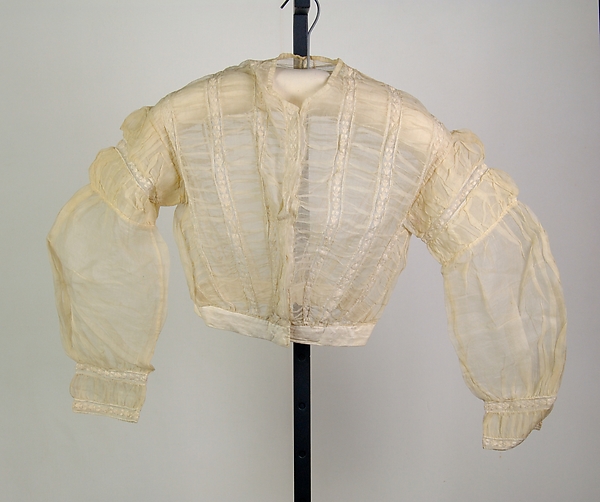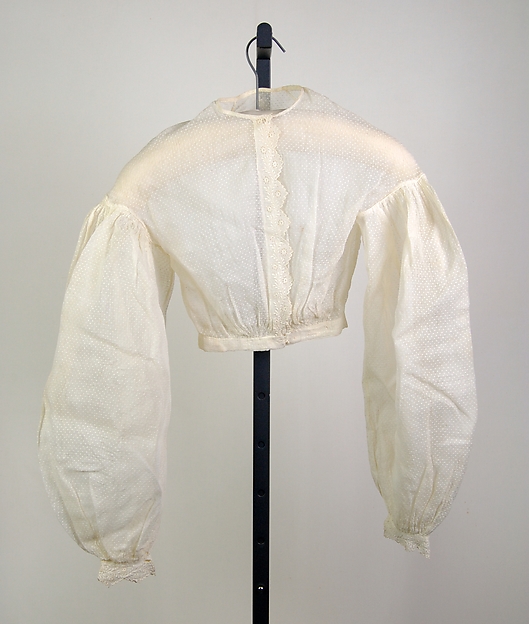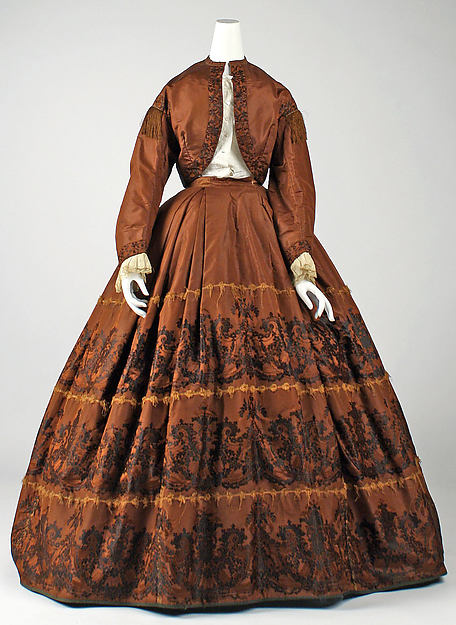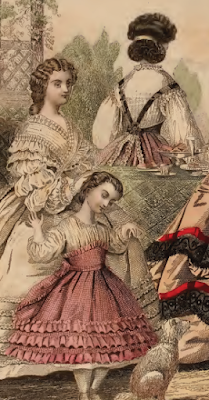 |
| "Chemisette" for wear with a Spanish or Zouave jacket. Peterson's, Dec. 1862. |
 |
| Sheer cotton body with vertical shirring, c. 1860, from The Met. |
 |
| Smooth-fitting waist of sheer, dotted cotton with lace accent, c. 1865, from The Met. |
 |
| Silk dress c. 1860-65; it's hard to tell whether it's a separate silk jacket meant to wear over a white body, or if it's a bodice intended to mimic the appearance of such a combination. From The Met. |
 |
| The girl's white muslin** guimpe is worm with a silk-trimmed grenadine skirt and matching corsage. The standing lady wears hers with a purple grenadine skirt and black velvet girdle and bretelles. Godey's, August 1863. |
| White waist worn with a (likely silk) skirt, contrasting jacket, and narrow belt. The Love Letter (1863) by Auguste Toulmouche. |
| Il Primo Dolore (The First Sorrow, 1863) by Silvestro Lega The girl wears a white body with controlled fullness, a contrasting skirt, and a pointed ('Medici') girdle or belt. |
The Garibaldi ensembles favor bright colors and militaristic trim.
 |
| Garibaldi dress, Frank Leslie's Ladies' Magazine, 1862. |
Like the white waists, the Garibaldi blouses tend to have controlled fullness, and most favor a "bishop" style full sleeve with a cuff. The main difference is material (colored wool versus white cotton), a somewhat looser fit at or just above the waist, and the occasional use of bodice material to trim the skirt (as in the two example above). One gets the sense that white waists are true separates--one could mix and match various combinations of skirt, body, belt, and/or jacket--while the Garibaldi is a two-piece ensemble: one shirt made to wear with one skirt. Some children's Garibaldi dresses (Godey's, '62, page 20-21) even appear to be one piece: a gathered bodice and skirt with no waistband (and the characteristic loose fullness thereat), and the usual full bishop sleeves.
Though not conclusive, Garibaldi shirts seem more likely to have collars than white waists do, and may or may not have a waistband.
 |
| Garibaldi shirt, Godey's, 1862. This version fits smoothly at the shoulders, and is relatively relaxed at the waist. |
 |
| Another collared Garibaldi without a waistband: this version from Godey's (1862) has a narrow yoke across the shoulder. |
Small jackets of various styles may be worn with with a Garibaldi shirt, white waist, or chemisette (or even over a dress). These are of diverse design and material, though as with the skirts the examples are fine wools, silk, or velvet, with ribbon and braidwork trim. I've seen no examples done in prints, or any sort of cotton.
 |
| Zouave jacket; note the Garibaldi-style fullness at the upper waist. Arthur's Illustrated Home Magazine, 1861 |
 |
| Zouave jacket and chemisette. Peterson's 1862 |
 |
| Zouave jacket of "fine crimson flannel" with silk braid and ribbon. Worn over a merino morning negligee. Harper's (1862) |
 |
| Godey's (1862), this braid-bedecked poplin**** jacket is worn with a matching skirt, over a "puffed" chemisette and undersleeves. |
 |
| Jacket styles--some open, some not--from Arthur's (1862). |
 |
| Half-high silk jacket or "corsage Jeanne d'Arc", worn with a chemisette and undersleeves. The Lady's Friend (1864) |
Two-piece ensembles are (obviously) another huge and diverse topic, but I hope this post offered a succinct introduction to them. As always, consider material, construction, and purpose when reproducing a garment or purchasing one for living history use. I'll be adding a separate post on ladies' belts shortly. [Edited to add: here it is!]
*"Chemisette" can also refer to an undershirt (or a sideless partial undershirt) used to fill in the neckline of some dresses, particularly those with deep V-necks.
**Period muslin is a fine cotton material (not like modern utility muslin--for modern equivalents look at fine lawns or batistes). Grenadine is "an open silk or silk and wool textile used for dresses", according to Textiles in America 1650-1870; it goes on to indicate that this light-weight material is similar to barege, that the threads are matte (and sometimes mistaken for linen) and that the cheapest grenadine is all-wool. Period velvet has a pile like modern velvet, but was made of silk, wool, or cotton, while readily-available modern velvet is mostly polyester (even the silk velvet is often a poly pile on a silk ground). Period "velveteen" may mean a cotton velvet, or an "extra-weft" pile fabric (velvet has an "extra warp" pile). Interestingly, though off-topic, Textiles in America also describes a type of upholstery velvet made of linen and goat hair. The "bretelles" are decorative straps running from waist to shoulder (and back down).
.
***All types of fine wool: mohair is made from the wool from angora goats; merino from merino sheep (who have very soft fleeces, as this spinner can attest); mousseline-de-laine (French, "muslin of wool") is "a fine woolen fabric." All definitions from Textiles in America. "Tweed" is not named therein, but other period references describe "tweed-cloth" as "light and not expensive...also soft and pliable" (Journal of the Board of Arts and Manufactures, 1861) and "a light mixed fabric...belonging legitimately...to the fine cloth manufacture" (The History of the Shoddy-Trade, 1860; here "shoddy" means wool fabrics made from mixing sheep's wool with shorter-staple "shoddy or rag-wool").
****Poplin being a lightweight silk-wool blend.

No comments:
Post a Comment